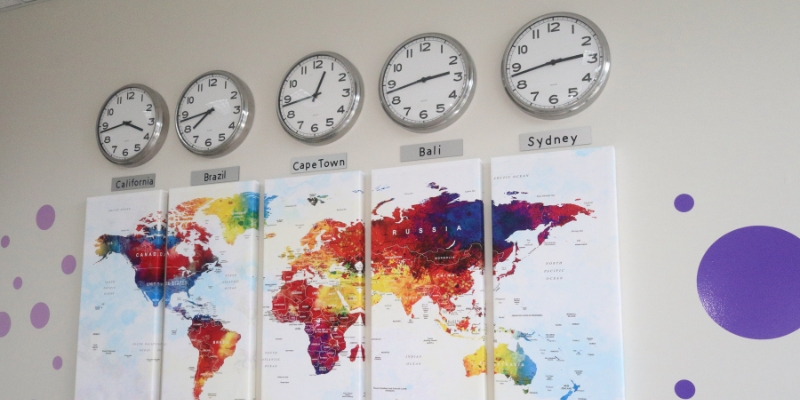Distributed teams have become the norm in the ever-evolving landscape of technology delivery.
While the distributed approach offers numerous benefits, it also presents unique challenges that can hinder collaboration and productivity.
From communication barriers to time zone differences, these obstacles can impede the seamless flow of ideas and prevent the project from succeeding. However, with the right strategies and tools, these challenges can be overcome. They can enable distributed teams to thrive and deliver exceptional results.
In this article, we will explore the common challenges distributed technology delivery teams face and provide practical tips for overcoming them, ensuring effective collaboration and successful project outcomes.
Challenges of Distributed Team in Technology Delivery

In the realm of technology delivery, distributed teams face a unique set of challenges. These can negatively impact their progress and cause collaboration to suffer greatly.
#1. Ineffective Communication
One of the primary obstacles is communication barriers. When team members are spread across different locations, time zones, and even cultures, effective communication becomes a critical challenge.
Misinterpretations, delays in response, and a lack of face-to-face interaction can lead to misunderstandings and destroy the seamless flow of ideas. Without clear and efficient communication channels, important information can get lost in translation, resulting in errors and a breakdown in collaboration.
#2. Unclear Common Target

Another challenge that distributed technology delivery teams often encounter is the lack of a shared understanding and alignment on the goal. When team members are physically separated, it becomes more difficult to establish a common vision and ensure everyone is on the same page. It is often a similar problem, even in face-to-face interaction.
However, there, you can at least see that gap by a simple look into the eyes :). In the case of remote setup, and let’s say without adequate presence of the cameras during the calls, you would need to be a telepath to sense those issues.
Differences in work styles, priorities, and even cultural norms can create misunderstandings. It challenges the team’s ability to work cohesively towards a shared goal. Without a strong sense of alignment, team members may end up working in silos, duplicating efforts, or even working against each other, leading to inefficiencies and suboptimal outcomes.
#3. Multiple Time Zones in a Team

Time zone differences also pose a significant challenge for distributed teams. When team members are spread across different time zones, scheduling meetings and coordinating work becomes complex. It can be challenging to find overlapping working hours where everyone can be available for real-time collaboration.
The situation naturally evolved so that people with later time zones tend to dictate to people from earlier time zones to stay longer at work to catch up with the various meetings. This can be a problem. How big? That depends on the people’s current life situation and, to some extent, also on where they come from.
The closer to the east time zone, the more accepting people tend to be of later working hours (and they shift their work-life balance significantly towards the late evening hours). But that’s not the same with people from central Europe, for example.
#4. Breaking the Standards
Taking me as an example, having two kids and a lot of work around the house, I can hardly imagine starting my work later during the day (say at 10:00 a.m.) and ending at 07:00 p.m. or later. That’s just not feasible. Children will come back home at 05:00 p.m. at the latest, and you can forget about any meaningful calls, even video calls. It does not help me in any way if I start my work later in the day.
On the other hand, I would have no problem starting my work at 05:00 a.m. in such a situation. However, if I suggest that to my colleagues from US time zones, they are usually not overly happy with such a suggestion :). So, we are all different.
Anyway, such a setup will ultimately result in delays in decision-making, slower response times, and a lack of immediate support when issues arise. The asynchronous nature of work can also lead to a sense of disconnection, disabling the team’s ability to work together seamlessly.
Naming the Challenges
To overcome these challenges, you shall adopt various strategies and tools (very obviously). Establishing clear communication protocols, leveraging technology platforms for real-time collaboration, and fostering a culture of transparency and inclusivity are essential.
Regular video conferences, virtual team-building activities, and knowledge-sharing sessions can help bridge the gap and improve a sense of friendship among team members. Additionally, utilizing project management tools and establishing clear workflows can help streamline processes and ensure everyone is aligned on s a common goal.
But let’s dive deeper into the resolution phase here.
By acknowledging and addressing these challenges head-on, distributed technology delivery teams can overcome the obstacles that come with their unique setup regardless of physical distance.
#1. Cultural and Language Differences
When team members come from diverse backgrounds, cultural and language differences can pose challenges. Varied communication styles, different work norms, and language barriers lead to misunderstandings and misinterpretations. It’s not uncommon for you to come to a meeting and agree on a conclusion, but everybody on the call understands that conclusion differently. Later, many people are surprised when the result of the “agreement” is in place.
It is crucial to emphasize a culture of inclusivity and promote open dialogue to bridge these gaps. Therefore, you shall encourage the team members to embrace cultural diversity and provide language support, such as translation tools or language training, which can help overcome these challenges.

You can also bring specialized diversity and inclusion training for the people so that they are aware of those differences.
#2. Trust and Relationship Building
Building trust and strong relationships among team members is far more challenging in a distributed setup. Without regular face-to-face interactions, it can be difficult to establish personal connections. Team members may hesitate to ask for help or share their ideas openly.

To address this, virtual team-building activities, regular check-ins, and creating opportunities for informal conversations can help improve trust and strengthen relationships within the team. You can plan regular online coffee chats, personal one-to-one calls, or anything that effectively substitutes those famous chit-chat conversations in the office kitchens.
People need those interactions in regular supplies; otherwise, they just lose interest in or any kind of loyalty to the team.
#3. Knowledge Sharing and Collaboration
In a distributed team, knowledge sharing and collaboration can be pushed down by the lack of physical proximity. Spontaneous discussions, brainstorming sessions, and informal knowledge exchanges that often happen in a co-located environment may be more challenging to replicate.
Leveraging technology tools such as collaborative document-sharing platforms, virtual whiteboards, and project management software can facilitate knowledge sharing. Encouraging team members to actively share their expertise and providing platforms for cross-functional collaboration can help overcome this challenge.
Addressing the Unique Challenges of Collaboration in Distributed Teams
Addressing the unique challenges of collaboration in distributed teams requires a thoughtful approach. Here are some of the approaches that technology projects can adopt.
#1. Utilize Collaboration Tools
Technology projects can leverage a wide range of collaboration tools to facilitate communication and teamwork. Platforms such as Slack, Microsoft Teams, or Zoom provide real-time messaging, video conferencing, and document-sharing capabilities. These tools will allow your team members to communicate effectively, share updates, collaborate on documents, and maintain a sense of connection despite physical distance.
#2. Implement Agile Methodologies
Agile methodologies, such as Scrum or Kanban, can be particularly effective for distributed teams. These frameworks emphasize frequent communication, transparency, and iterative development. Regular stand-up meetings, sprint planning sessions, and visual project boards help keep everyone aligned and enable quick adaptation to changing circumstances.
#3. Earning the Trust
Despite many leaders saying how they are building trust, that’s not something you can do. You can only earn the trust. Trust is crucial for distributed teams. Project leaders should encourage open communication, active listening, and respect for diverse perspectives. Creating a safe environment where team members feel comfortable sharing their ideas, asking for help, and working at their best is the essence of successful project execution.
#4. Define Communication Protocols
Clear communication protocols are vital for distributed teams to overcome communication barriers. Establishing guidelines for communication channels, response times, and meeting schedules helps ensure that team members are on the same page.
It is also important to define expectations for sharing progress updates, documenting decisions, and resolving conflicts. For each such topic, you shall have a well-defined regular process that everybody can count on.
#5. Knowledge Sharing and Learning
Encouraging knowledge sharing and continuous learning is crucial. Establishing a knowledge-sharing platform, such as a wiki or internal blog, can facilitate the exchange of ideas, best practices, and lessons learned.
Regular virtual training sessions, webinars, or lunch-and-learn sessions can also help team members expand their skills and stay updated on industry trends. I know it’s an additional effort to ask people to invest in. Not always and not everyone will be open to such initiatives. The ultimate job of the project leadership is to find a way how to create a spark for such activities inside the team.
Common Obstacles to Deal With
Even if you are all set to resolve your collaboration problems inside the team, it’s not all about the plan. You also need to count on the obstacles that will eventually cross your way. They are inevitable, but they are also resolvable.
Lack of Face-to-Face Interaction
The absence of face-to-face interaction in distributed teams impacts your relationship building, trust, and collaboration. To mitigate this challenge, just promote video conferencing tools for virtual meetings, allowing team members to see each other and build a sense of connection. Regular virtual team-building activities, such as icebreaker sessions or virtual coffee breaks, can also improve a lot of things and strengthen relationships despite the physical distance.
Cultural Differences
Cultural differences ultimately lead to misunderstandings and misinterpretations among team members, and you can’t avoid that. It would be a problem even with different families in the same town, not even with different people from different continents.
It is important to foster cultural sensitivity and promote open dialogue to bridge these gaps. Encouraging team members to share their cultural perspectives, providing cultural awareness training, and establishing guidelines for respectful communication can help overcome cultural barriers and promote a more inclusive and collaborative environment.
Technology Challenges
Distributed teams heavily rely on technology for communication and collaboration. Technical issues, such as unstable internet connections or incompatible software, can disrupt workflow and hinder productivity. To address this, you should ensure that all members have access to reliable technology infrastructure and provide technical support when needed. Regularly evaluating and updating the technology stack can also help mitigate potential challenges.
Practical Tips and Best Practices
Concluding the facts above, here are some tips and best practices for overcoming challenges and creating effective collaboration in distributed teams.
✅ Define and communicate the preferred communication channels for different types of interactions within the team. This could include email, instant messaging platforms, video conferencing, or project management tools. Ensure that team members are aware of the expected response times and availability to maintain effective communication.
✅ Leverage asynchronous communication methods to accommodate time zone differences and promote flexibility. Encourage the use of shared project management tools, where team members can leave updates, comments, and questions that can be addressed at a convenient time for each individual.
✅ Earn trust among team members by encouraging open and transparent communication. Create a safe environment where everyone feels comfortable sharing their ideas, asking for help, and providing feedback. Create a culture of inclusion by valuing diverse perspectives and promoting active listening.
✅ Schedule regular check-ins and meetings to ensure alignment and maintain a sense of connection. These meetings can discuss project updates, address challenges, and provide a platform for team members to share their progress and concerns. Rotate meeting times to accommodate different time zones and ensure everyone has an opportunity to participate.
✅ Utilize visual collaboration tools such as virtual whiteboards or shared document editing platforms. Facilitate brainstorming, idea sharing, and collaborative problem-solving. These tools enable team members to work together in real-time, regardless of their physical location.
✅ Improve a culture of knowledge sharing by providing platforms for team members to share their expertise, best practices, and lessons learned. This includes creating a knowledge base, hosting virtual training sessions, or organizing webinars. Here, team members can share their insights and experiences.
✅ Encourage social interaction among team members to build relationships. Organize virtual team-building activities, such as virtual coffee breaks, online games, or informal video chats, to create opportunities for informal conversations and bonding.
✅ If language barriers exist within the team, provide language support resources such as translation tools or language training. Encourage team members to communicate clearly and concisely. Avoid jargon or complex terminology that may be difficult for non-native speakers to understand.
Conclusion
In the face of challenges, distributed technology delivery teams have the opportunity to embrace innovation and collaboration. By leveraging effective communication, earning trust, and embracing diversity, these teams can overcome obstacles and achieve remarkable results. The distance is no longer an obstacle but rather an opportunity to build and improve upon.

